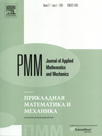 | | Journal of Applied
Mathematics and Mechanics
Russian Academy of Sciences | | Founded
in January 1936
(Translated from 1958)
Issued 6 times a year
ISSN 0021-8928
(print version) |
Archive of Issues
| Total articles in the database: | | 10610 |
| In Russian (ΟΜΜ): | | 9811
|
| In English (J. Appl. Math. Mech.): | | 799 |
|
| << Previous article | Volume 75, Issue 1 / 2011 | Next article >> |
| V.N. Paimushin and T.V. Polyakova, "The small free oscillations of a strip," J. Appl. Math. Mech. 75 (1), 49-55 (2011) |
| Year |
2011 |
Volume |
75 |
Issue |
1 |
Pages |
49-55 |
| Title |
The small free oscillations of a strip |
| Author(s) |
V.N. Paimushin (Kazan, Russia, dsm@dsm.kstu-kai.ru)
T.V. Polyakova (Kazan, Russia) |
| Abstract |
The refined equations of the free oscillations of a rod-strip, constructed previously in a first approximation by reducing the two-dimensional equations to one-dimensional equations by using trigonometric basis functions and satisfying the static boundary conditions on the boundary surfaces are analysed. These equations, the solutions of which are obtained for the case of hinge-supported end sections of the rod, are split into two independent systems of equations. The first of these describe non-classical fixed longitudinal-transverse forms of free oscillations, which are accompanied by a distortion of the plane form of the cross section. It is shown that the oscillation frequencies corresponding to them depend considerably on Poisson's ratio and the modulus of elasticity in the transverse direction, while for a rod of average thickness for the same value of the frequency parameter (the tone) they may be considerably lower than the frequencies corresponding to the classical longitudinal forms of free oscillations, which are performed while preserving the plane form of the cross sections. The second system of equations describes transverse flexural-shear forms of free oscillations, whose frequencies decrease as the transverse shear modulus decreases. They are practically equivalent in quality and content to the similar equations of well-known versions of the refined theories, but, unlike them, when the number of the tone increases and the relative thickness parameter decreases they lead to the solutions of the classical theory of rods. |
| Received |
05 February 2009 |
| Link to Fulltext |
|
| << Previous article | Volume 75, Issue 1 / 2011 | Next article >> |
|
 If you find a misprint on a webpage, please help us correct it promptly - just highlight and press Ctrl+Enter If you find a misprint on a webpage, please help us correct it promptly - just highlight and press Ctrl+Enter
|
|

 Russian
Russian  English
English